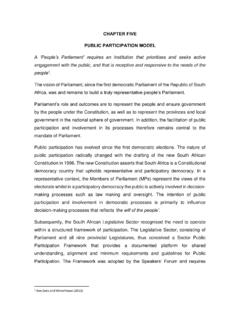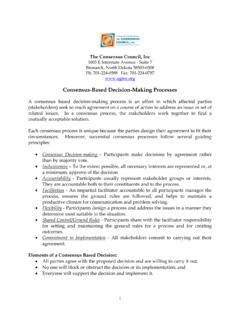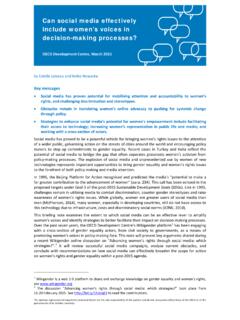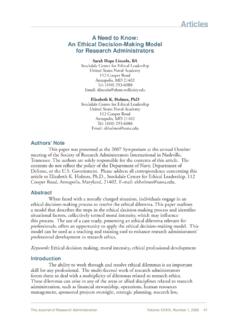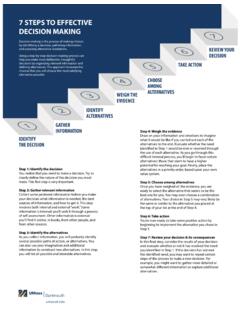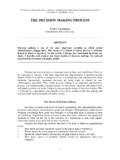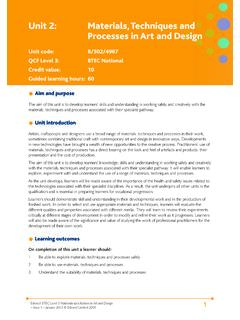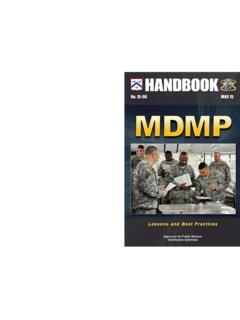Transcription of Equal Participation of Women and Men in Decision-Making ...
1 EGM/EPDM /2005/REPORT United Nations Division for the Advancement of Women (DAW) Department of Economic and Social Affairs (DESA) Economic Commission for Africa (ECA) Inter-Parliamentary Union (IPU) Equal Participation of Women and Men in Decision-Making processes , with Particular Emphasis on Political Participation and Leadership Report of the Expert Group Meeting Addis-Ababa, Ethiopia 24 27 October 2005 Division for the Advancement of Women Department of Economic and Social Affairs 2 UN Plaza, 12th Floor New York, NY 10017 Fax: (212) 963-3463 Email: Website: 2 TABLE OF CONTENTS Pages I. 3 II. Organization of 3 A. B. C. Programme of D. Election of E. Working F. Opening 3 3 4 4 4 4 III. 5 A. Plan of the B. International policy C. Conceptual D. Why more Women ?: Rationale, numbers, and beyond 5 5 7 8 IV. Increasing the number of Women in Decision-Making : A focus on national 15 A.
2 Factors that enhance or hinder Women s B. Mechanisms for increasing Women s Participation , representation and 15 17 V. Beyond numbers: the impact of Women s political Participation and representation .. 18 A. Conditions that enable Women to be effective in Decision-Making 1. Critical 2. Critical 3. Critical B. The impact of Women s Equal Participation in Decision-Making 19 19 20 22 23 VI. Recommendations .. 25 A. Recommendations for increasing the number of Women in B. Recommendations for enhancing the impact of increased presence of Women in 25 27 Annexes Annex I. List of Annex II List of Annex III Programme of 31 34 36 3 I. INTRODUCTION 1. In accordance with its multi-year programme of work for 2001-2006, the Commission on the Status of Women (CSW) will consider Equal Participation of Women and men in Decision-Making processes at all levels as one of two thematic issues during its fiftieth session in 2006.
3 In order to contribute to a further understanding of this issue and to assist the Commission in its deliberations, the United Nations Division for the Advancement of Women (DAW) in the Department of Economic and Social Affairs, in collaboration with the Inter-Parliamentary Union (IPU) and the Economic Commission for Africa (ECA), organized an Expert Group Meeting (EGM) on Equal Participation of Women and men in Decision-Making processes , with particular emphasis on political Participation and leadership . The EGM was hosted by the Economic Commission for Africa in Addis Ababa, Ethiopia, from 24 to 27 October 2005. 2. The findings and recommendations of the Expert Group Meeting will be presented at the panel discussion on Equal Participation of Women and men in Decision-Making processes during the fiftieth session of the Commission on the Status of Women . 3. The expert group meeting analyzed the current situation of Women in Decision-Making processes , with particular emphasis on Women s political Participation and leadership at the international, national, regional and local levels.
4 It discussed the conditions that facilitate Women s representation in Decision-Making processes within the context of current socio-economic and political transformations, and examined the linkages between Women s presence in Decision-Making and their impact on the mainstreaming of a gender perspective into policies and programmes. The expert group meeting adopted policy recommendations to advance Women s Participation and leadership through, inter alia, capacity-building, coalition-building and gender-sensitive institutional policies, programmes and mechanisms, based on the identification of the most promising practices and lessons learned to date. The report that follows is the outcome of deliberations of the independent experts. II. ORGANIZATION OF WORK A. Participation 4. The Expert Group Meeting (EGM) on Equal Participation of Women and men in Decision-Making processes , with particular emphasis on political Participation and leadership was attended by nine independent experts from different regions and six observers (three from the United Nations, two members of parliament (MPs) and one parliamentary staff person from Kenya), one consultant.
5 Two representatives from the Division for Advancement of Women , four representatives from ECA and one representative from the IPU also attended the meeting (See annex I). B. Documentation 5. The documentation of the meeting consisted of: 4- a background paper prepared by a consultant on behalf of the Division for the Advancement of Women - an overview paper prepared by IPU - twelve papers prepared by experts - two papers prepared by observers 6. This report and all documentation relating to the meeting are available online at the website of the Division for the Advancement of Women : C. Programme of work 7. At its opening session on 24 October 2005, the meeting adopted the following programme of work (see Annex III): - Opening of the meeting - Election of officers and adoption of the programme of work - Presentation and discussion of the Division for the Advancement of Women s background paper and papers prepared by experts and observers - Working groups on issues and recommendations - Introduction of draft report - Adoption of final report - Closing session D.
6 Election of officers 8. The experts elected the following officers: Chair: Amede Obiora (Nigeria) Rapporteur: Amy Mazur (USA) E. Working groups 9. Two working groups were established: - Working group I Increasing numbers , rapporteur Teresa Sacchet (Brazil) - Working group II - Women making a difference , rapporteur Fiona Macaulay (UK) F. Opening statements 10. The meeting was opened by Ms. Thokozile Ruzvidzo, Officer in Charge, African Centre for Gender and Development, (ACGD), a division of the ECA. In her welcoming statement, Ms. Ruzvidzo noted the importance of the meeting on Equal Participation of Women and men in Decision-Making . She emphasized that the issue of Women s Participation in Decision-Making in Africa continued to be of serious concern. However, due recognition needed to be given to the progress that has been made on the continent. The Africa Union Constitutive Act is a leading example, as it requires the African Union to have a 50 percent representation of Women commissioners.
7 Such an approach needs to be emulated in other institutions, including in the UN. She indicated the full 5support of the African Centre for Gender and Development for the meeting and wished the experts a successful outcome. 11. Ms. Roselyn Odera, Chief of Gender Analysis Section at the Division for the Advancement of Women , presented a statement on behalf of Ms. Carolyn Hannan, Director of the Division. She thanked IPU and ECA for collaboration in the preparation of the meeting, and the ECA, in particular, for hosting the meeting. She welcomed the international experts, members of Parliament, United Nations system representatives and observers from governmental and non-governmental organizations. In her statement, Ms. Hannan identified major achievements and challenges in promoting Women s Equal Participation in Decision-Making processes at all levels. She indicated that the expert group meeting had a special significance for the fiftieth session of the Commission on the Status of Women , and noted that the conclusions and recommendations of the meeting would assist the Commission in its deliberations on the thematic issue.
8 III. BACKGROUND A. Plan of the report 12. This report maps out various facets of the complex issue of the Equal Participation of men and Women in Decision-Making identified by the experts. The report begins with a section which presents the international policy framework, followed by the conceptual framework for the report. Experts views in support of increasing numbers of Women in Decision-Making , the status of Women in positions of power, and the importance of going beyond numbers to assess the impact of Women in top positions are then discussed. The issues of increasing the number of Women and the quality of Participation and representation are examined in sections IV and V of the report. The report concludes with the presentation of recommendations made by the experts in these two key areas. B. International policy framework 13. The Fourth World Conference on Women , held in Beijing in 1995, drew attention to the persisting inequality between men and Women in Decision-Making .
9 The Beijing Platform for Action reaffirmed that Women s persistent exclusion from formal politics, in particular, raises a number of specific questions regarding the achievement of effective democratic transformations, in practice. It undermines the concept of democracy, which, by its nature, assumes that the right to vote and to be elected should be equally applied to all citizens, both Women and men. The absence of Women from political Decision-Making has a negative impact on the entire process of democratization. In addition, democratic institutions, including parliament, do not automatically achieve gender equality in terms of representation, or in terms of policy agenda setting and accountability. 14. The Beijing Platform for Action emphasized that Women s Equal Participation in Decision-Making is not only a demand for justice or democracy, but can also be seen as a necessary condition for Women s interests to be taken into account. Without the perspective of Women at all levels of Decision-Making , the goals of equality, development and peace cannot be achieved.
10 (Para 181) 15. The Beijing Platform for Action defined two strategic objectives in its critical area of concern on Women in power and Decision-Making : 6 to ensure Women s Equal access to and full Participation in power structures and Decision-Making ; to increase Women s capacity to participate in Decision-Making and leadership. 16. The following measures were recommended by the Beijing Platform for Action for the implementation of the first strategic objective: to achieve gender-balanced composition in governmental bodies and committees, as well as in public administration and in judiciary, including through setting specific targets and, if necessary, establishing a positive action policy; to integrate Women into elective positions in political parties; to promote and protect Women s political rights; and to reconcile work and family responsibilities for both men and Women . 17. For the second strategic objective, the Platform for Action recommended the organization of leadership and gender awareness training; the development of transparent criteria for Decision-Making positions; and the creation of a system of mentoring.










